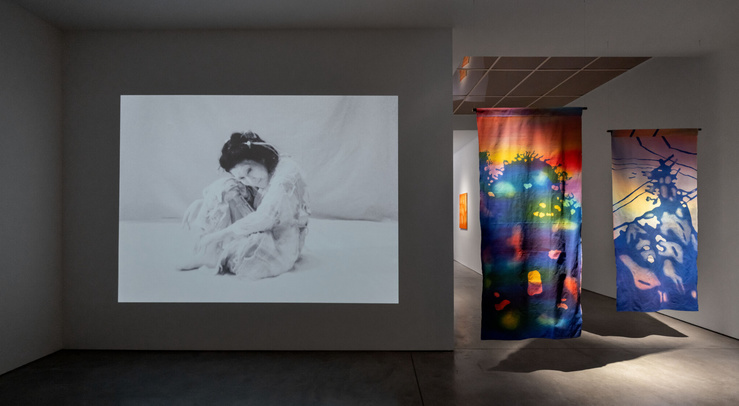
Ulla von Brandenburg — Galerie Art : Concept
As is her custom, Ulla von Brandenburg immerses the viewer in an otherworldly realm in her new exhibition at Art : Concept gallery, never concealing the element of play and staging necessary for an experience that transcends mere illusion.
Here, the gaze is drawn into a plural formal language — fabric compositions and a black-and-white film, with pronounced grain and tight framing — that lifts the viewer out of time. But this is no trickery: the artist’s aesthetic pact turns the visitor into an active prisoner of a textile labyrinth, evoking in turn the material swirls of dripping pigment, the metaphorical landscapes from which they arise, spectral entities haunting their legends, and at times human forms quietly moving through space.
The installation, while suggesting the floating lightness of fabric, asserts its presence. These upright textiles, dyed in indigo or marked by strong contrasts, become thresholds to cross, filters to pass through, where light refracts, diminishes, becomes tangible matter. Ulla von Brandenburg explores the notion expressed by the Japanese word kekkai — meaning both “separation” and “connection” — a boundary-space, an in-between, a gap in which the eye and the mind suspend judgment. A place where perception thickens.
Inspired by her 2024 residency at Villa Kujoyama, Ulla von Brandenburg draws from traditional Japanese textile techniques — notably katazome — and from an aesthetics of shadow dear to Jun’ichiro Tanizaki. In In Praise of Shadows, Tanizaki contrasted the harsh, invasive light of the West with the delicacy of Eastern penumbras. Ulla von Brandenburg does not merely illustrate this idea; she brings it to life, treating light as a moving material, revealing the hidden folds of an interior spatiality where opacity becomes a condition for revelation.
In this sense, the installation becomes a sensitive device, where the experience of threshold takes on the value of ritual, of passage. The noren — a traditional Japanese split curtain — hanging at the entrance, immediately imposes a gesture: the act of parting, of sliding the body through the fabric; one brushes against it or bends beneath it, reluctant to crease it. The fabrics, though light, appear more erected than floating, saturated with their striking contrasts, reflecting their own light rather than playing with transparency. The authority of a story wrapped in the softness of its adornments. These curtains conceal nothing but the space already entered — which they reveal anew, inviting a sensory journey that never reduces itself to the senses alone.
At the edges of these textiles emerges the figure of the yokai, at the heart of the film projected at the end of the exhibition path, crystallizing those marginal presences, fleeting apparitions that only a porous attention can perceive. These mythological creatures do not reveal themselves clearly; they surface in the friction between worlds, on the threshold between visible and invisible, in the vibration of elements. Ulla von Brandenburg’s cinema, an intimate extension of the installation, embraces a logic of persistence — a formation within the unformed. The image gains a nearly tactile density. It intertwines personal reflection, mythological storytelling, and the capture of ritual gestures drawn from traditional theater. This shadow theater becomes a space of learning — of seeing and listening — a lesson in letting go through rigor and repetition.
Thus, the work unfolds as a meditation on thresholds: neither entirely here, nor already elsewhere. A transitional space where one perceives not fixed forms, but figures in the making. Where monsters are not seen, but where their emergence is felt — in a fold of fabric, a breath of air, a flicker of light.
Ulla von Brandenburg achieves the remarkable feat of reviving, through a traditional technique, a form of expression that is fully contemporary. The trembling lines, fragile forms, and feverish contours reflect the unsettling proximity of an inner world to be transcended. An unexpected encounter between Japanese aesthetics and Western folklore, inhabited by entities perceived only in the heartbeat of nature, the breath of life upon things, the hollow of shadows, and the gleam of dancing reflections.
And so, the figures from traditional theater captured by Ulla von Brandenburg begin to dance, creating in their movement the possibility of brushing against the margins, of letting other lives emerge. In reality or in thought — it hardly matters — so long as we feel the ground shift beneath our feet: firmly present, yet always at the edge of the place it occupies, perpetually balanced on the threshold of a world yet to be inhabited.
Ulla von Brandenburg, Kekkai, Art : Concept, Paris — May 24 — July 26, 2025 Read more










